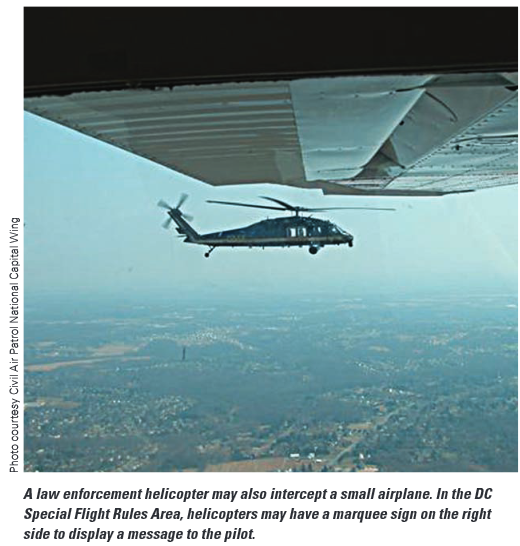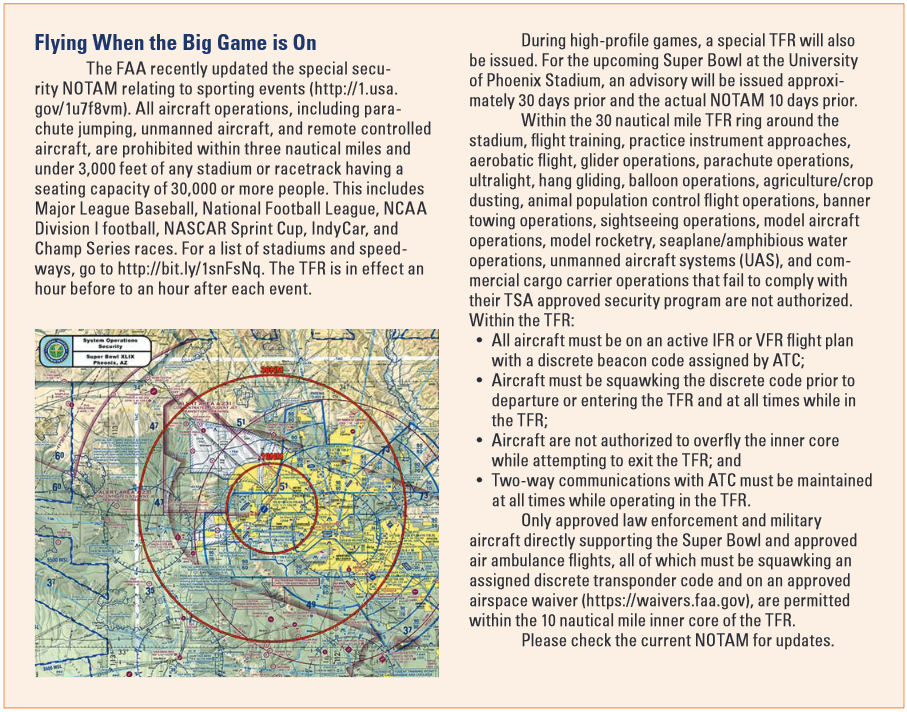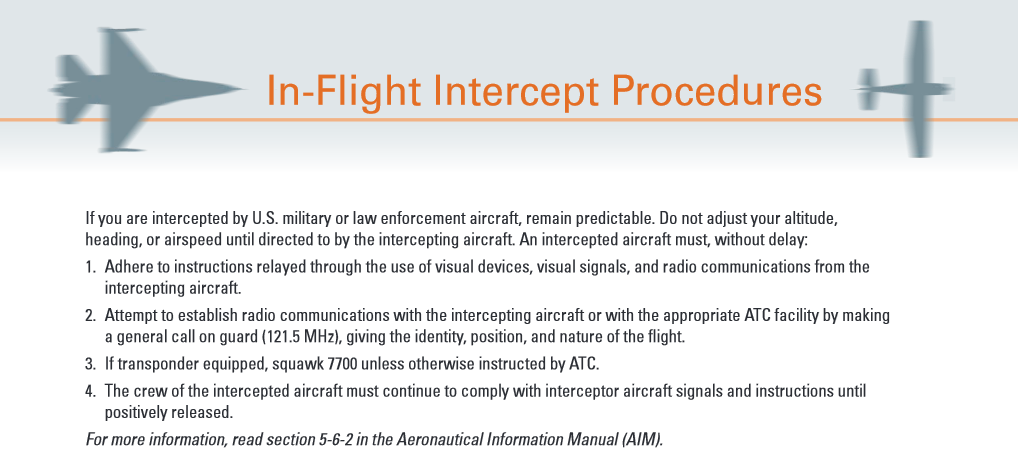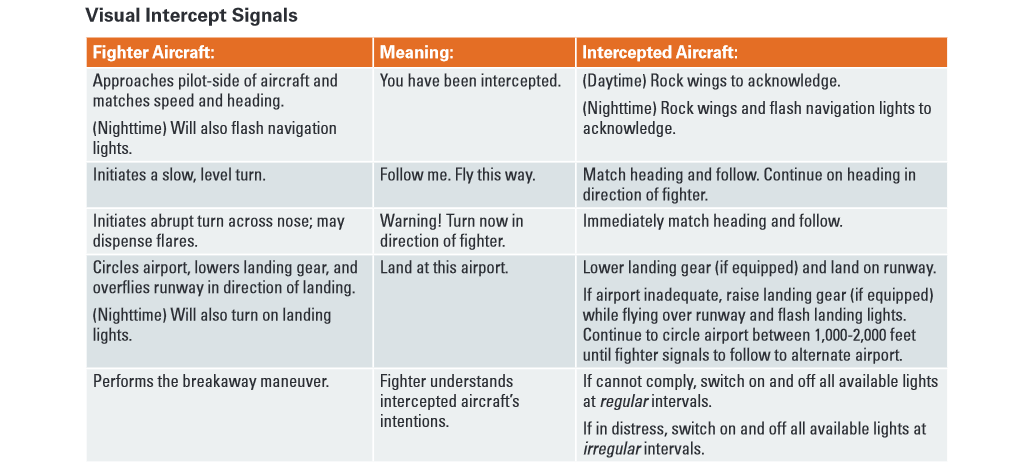You’ve Been Intercepted!
Behind the Scenes of a TFR
Source: www.faa.gov/news/safety_briefing, By Paul Cianciolo
Today is one of those perfect weather flying days. It’s so nice outside that you cancel your plans and take your airplane out for a joyride. Everything is going well — fuel was cheaper than expected, the air is smooth, and you’re heading to your favorite fishing spot. Nothing can put you in a bad mood today.
That is ... except for that F-16 on your left outside the window rocking back and forth. You begin to think, “uh-oh, where am I!? What did I do?” You flip the radio over to COMM 2, which is programmed to 121.5 MHz, and hear: “... Cessna on heading 130, you have entered restricted airspace.” This is no longer a good day, and now you think: “Just what are those in-flight intercept procedures that I thought I would never need?”
Similar scenarios played out in the National Airspace System (NAS) as the military’s Continental U.S. NORAD Region (CONR) responded to more than 170 “tracks of interest” (TOIs) so far this year. It is down from the more than 190 TOIs investigated in 2013, but that’s still way too many pilots unintentionally causing America’s AOC (the 601st Air and
Space Operations Center) at Tyndall Air Force Base, Florida, to scramble fighter jets and helicopters to stop a joyride in the wrong place at the wrong time.
Accessing the Airspace
A temporary flight restriction (TFR) can pop-up at any time, even without advanced notice. It can feel like you are bouncing around the NAS in an epic game of pinball. However, you can take comfort in knowing that the FAA is on your side with keeping the game in your favor.
Providing “free access to our airspace” is a mandate that the FAA’s Office of System Operations Security takes very seriously. The office serves as a referee between pilots and local, state, tribal, and federal government officials requesting that certain airspace be restricted for an event or incident.
The FAA gets requests from virtually every police department, city council, mayor, and town manager with an event that they believe merits a TFR. Only one out of 10 requests actually becomes a TFR.

Examining the Risks
The system operations security staff starts by reviewing potential threats and operational mission needs against the likely impact that the TFR will have on normal air traffic, including general aviation (GA) flights. This analysis includes ongoing consultation with interagency stakeholders such as the Transportation Security Administration (TSA) and FBI. In most cases, after consulting with these partners, no credible threat is found and the TFR request does not meet the requirements for restricting the airspace.
On the rare occasions when the TSA or FBI believes that there is a credible threat, the FAA will establish a TFR.
However, once a TFR is agreed upon, the FAA’s priority shifts to determining how the restrictions will impact the flying community and can be mitigated. An air traffic control filter is applied each time. Can the restricted airspace be 58 miles out versus 60? Can the TFR be activated 10 minutes later? Could there be a cut-out area for an airport on the fringe? Can GA gateway airports be established? The FAA tries to lessen the impact on normal airspace users whenever possible.
Gaining Situational Awareness
The FAA’s biggest challenge is letting pilots know about TFRs, especially those that pop up under tight time constraints. In addition to staying on top of the latest Notices to Airmen (NOTAMs), a very helpful thing that a pilot can do to see and avoid a TFR is to have the capability to receive Automatic Dependent Surveillance-Broadcast (ADS-B) in the cockpit.
According to the FAA’s Surveillance and Broadcast Service Program Office, TFRs — both text and graphical — are scheduled for transmission through ADS-B ground stations as soon as they are received. The initial TFR transmission starts within 10 seconds of receipt. After the initial transmission, the TFRs are retransmitted on a periodic basis of at least once every 10 minutes until they expire.
Although ADS-B In capability is optional, ADS-B Out capability will be required in five years. Having ADS-B In will significantly improve a pilot’s situational awareness in the cockpit.
Other ways to check for TFRs include going online to trf.faa.gov, calling Flight Services at 1-800-WX-BRIEF (992-7433), and subscribing to email alerts from the Safety Program Airmen Notification System (SPANS) at faasafety.gov/spans. It’s important to check just before your flight. You never know when a TFR will pop-up.
What Do I Do Now?
Let’s go back to Joe Pilot on his intended fishing trip. He has now been intercepted by a pair of fighter jets ready to defend the airspace. Lucky for Joe, he has his in-flight intercept procedures handy. If you need a refresher, see the intercept procedures chart on the next page.
Next, Joe notifies ATC of his predicament and acknowledges the F-16 by rocking his wings. He then follows the Fighting Falcon and lands where directed. Joe eventually gets back on his way, but the entire episode (and the associated inconvenience and expense) could have been avoided. Please make it a priority to check for TFRs before every flight so
you don’t find yourself with an armed escort!




Paul Cianciolo is an assistant editor and the social media lead for FAA Safety Briefing. He is a U.S. Air Force veteran, and a rated aircrew member and search and rescue team leader with the Civil Air Patrol. |